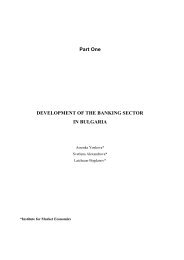Rules, Regulations and Transaction Costs in Transition Bulgaria
Rules, Regulations and Transaction Costs in Transition Bulgaria
Rules, Regulations and Transaction Costs in Transition Bulgaria
You also want an ePaper? Increase the reach of your titles
YUMPU automatically turns print PDFs into web optimized ePapers that Google loves.
Valid<br />
percentage<br />
"Highest<br />
cost"<br />
Total Production Trade Service<br />
s<br />
Sofia Large<br />
district<br />
centre<br />
Smalle<br />
r town<br />
Rentals 42.5 21.7 57.4 20 35.3 53.6 37.1<br />
Labour 39 55.6 25 69.2 38.9 30.3 44.9<br />
Market<br />
surveys<br />
22.5 22.2 11.8 60 16.7 20 26.3<br />
Office<br />
ma<strong>in</strong>tenance<br />
16.2 17.2 17.9 7.1 6.3 14.7 20.4<br />
Commissions<br />
cash<br />
11.1 9.1 15.4 0 20 0 13.3<br />
Transport<br />
costs<br />
10.2 0 12.9 20 20 8.6 8.3<br />
Advertis<strong>in</strong>g 9.1 6.3 13.6 0 14.3 0 15<br />
Representati<br />
ve<br />
5.3 14.3 0 0 25 0 0<br />
Insurance<br />
<strong>and</strong> security<br />
0 0 0 0 0 0 0<br />
In general terms, the largest number of firms - 42% - f<strong>in</strong>d that rentals are the highest costs they <strong>in</strong>cur. For 39% of<br />
the firms, the highest costs are connected with labour, for 22.5% the market surveys rank first, <strong>and</strong> for 16.2% the<br />
highest costs are attributed to office ma<strong>in</strong>tenance. It is impressive that many firms - 11.1% - have <strong>in</strong>dicated as<br />
highest costs the commissions paid cash, that is to say the bribes. The largest percentage here is found<br />
accord<strong>in</strong>gly <strong>in</strong> the sector of trade (15.4%), <strong>and</strong> <strong>in</strong> Sofia (20%). This means that corruption gives rise to<br />
serious transaction costs for a significant number of firms <strong>in</strong> <strong>Bulgaria</strong>.<br />
III.B.5 <strong>Costs</strong> relat<strong>in</strong>g to the labour market <strong>and</strong> social security legislation<br />
Table 26 shows the percentage of total revenues spent on labour.<br />
Table 26<br />
Percentage Total<br />
1996<br />
Total<br />
2000<br />
Production Trade Service<br />
s<br />
Sofia Large<br />
district<br />
centre<br />
Smaller<br />
town<br />
Up to 5% 37.7 10.0 12.5 11.4 0 4.8 13.9 9.5<br />
5 - 15% 30.2 25.0 12.5 31.4 22.2 14.3 25.0 28.6<br />
15 - 25% 19.8 23.3 25.0 24.3 16.7 14.3 25.0 25.4<br />
25 - 50% 11.3 22.5 21.9 21.4 27.8 33.3 27.8 15.9<br />
50 - 100% 0.9 9.2 18.8 4.3 11.1 23.8 5.6 6.3<br />
Over 100% 0 0 0 0 0 0 0 0<br />
n/r 0 10.0 9.4 7.1 22.2 9.5 2.8 14.3<br />
S<strong>in</strong>ce 1996, labour costs have been gradually <strong>in</strong>creas<strong>in</strong>g <strong>and</strong> tend to move to the area above 25%.<br />
In order for an employee to receive 100 Levs, he or she must work out 176.65 Levs. In other words, the State<br />
must be paid 76.65 Levs <strong>in</strong> the form of taxes <strong>and</strong> social security contributions on every 100 Levs (See Table 27).<br />
Table 27: Tax <strong>and</strong> social security burden, 1991-2000<br />
36











